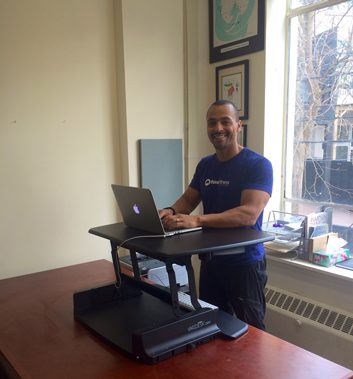Improve your health with an active office
Let’s face it: sitting for long hours has become the norm. Whether it’s driving in rush hour traffic or spending

Let’s face it: sitting for long hours has become the norm. Whether it’s driving in rush hour traffic or spending long hours sitting at the computer, this can wreak havoc on your posture and overall health.
Over the course of time, sitting has become so habitual that we don’t give it too much thought until we begin experiencing the negative impact it has on our health. When you take a look at today’s research it becomes obvious that society needs a serious paradigm shift when it comes to how we spend our time in the office. To add insult to injury, much of today’s conveniences and sedentary habits also keep us seated; watching television and leisure time surfing the Internet add additional hours. Many studies show that on average we are spending 60 hours per week in the seated position. We are consistently exposing our bodies to long hours of excessive flexion and internal rotation. Hip flexors become tight and shortened and shoulders become rounded forward while the muscles along the backside of the body become weakened. Associated postural stress on the spine can create chronic discomfort with back pain.
We do need to look beyond just the negative effects on posture toward the impact on our overall health. It has been shown in a recent study published in the Annals of Internal Medicine that excessive sitting can correlate to a 20 percent increased risk for cancer, heart disease and even premature death. The increased risk of developing diabetes can be as much as a 90 percent.
So, what can we do to work towards reversing these risks? It comes down to notion of moving more and sitting less. This is not just a matter of implementing exercise into your weekly routine, in fact it has been show that even regular exercisers can be susceptible to these health risks if they spend the rest of their day sitting at the office. It has become apparent that the total spectrum of movement within a 24-hour period is what’s most important. Take a look at where you spend your time sitting most; the solution is to alter our ‘sitting hours’, changing our habits at the office to essentially create an active office experience. Here are some effective ways you can make a big difference on your health by making small changes to your office routine.
Stand more
There are many products on the market now that cater to this increasing problem of prolonged sitting. I came into contact with Varidesk about a year ago and my life has transformed. It’s an adjustable stand up desk that allows you to easily incorporate standing into your workday at regular intervals. You just pop the system on your existing desk and it allows you to move from sitting to standing with the press of a button. I tend to sit for about 20 minutes when working at my desk and then switch to standing for 20 minutes. This unit can be ordered and delivered from fitter1.com for around $350-400 with no installation required.
Move more
We were meant to move; society and work demands have pushed us toward sedentary habits. Incorporating simple tools into your office can increase postural awareness and get you moving more during your day. Using training tools like a wobble board or fit ball can help increase postural and core awareness while incorporating simple stabilizing movements throughout the workday.
Moving more starts with awareness. Try incorporating some simple habits into your workday, such as standing when you answer the phone or keeping a small glass of water at your desk so your refills are more frequent. Additionally, you may want to invest an activity tracker to help track your steps and provide a gauge as to how active you are each day. Having a goal and tracking your results can go a long way when it comes to building healthy habits.
Planning a purposeful exercise break into your day can be a great way to stay in shape at the office. Check out this Office Fit Workout for some great tips and exercises and stretches completed right at your desk.
Stretch often
Flexibility imbalances can be significantly exacerbated by long periods of sitting. Typically, the seated position forces the flexors of the hip and the internal shoulder rotators to be come tight and shortened. Try setting your computer alarm every 30 minutes as a reminder to stand up and stretch. I also set aside time within my workday to relax and release tight muscles using a couple of great tools like the foam roller. Here are some myofascial release exercises that you do which can help alleviate flexibility imbalances and reduce tension and discomfort.
Brent Bishop is an on-air fitness expert, celebrity trainer, author and owner of Think Fitness Studios.




